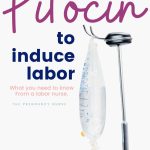📣 YOU are clearly getting prepared for pregnancy, birth & beyond — but do you wish your partner was more involved (looking for a teammate rather than just a cheerleader)? Couples love THIS! 💛🧡💚
Pitocin or Oxytocin is a hormone your body produces to start things like labor, breastfeeding, and more. Your body has been producing it for you for YEARS, so why is the internet so full of negativity about this hormone when used to start labor? Let’s talk about it, and how it is used in labor induction.
It is REALLY important that you take your information on Pitocin from an expert. There is a lot of VERY POOR information out there about this drug. Be very mindful of who you’re listening to. Pitocin saves lives, so when you hear it demonized — think again.
Grab my hospital packing list while you’re here;
What is Pitocin?
In nursing school we quickly learn that our entire body is made who we are by hormones. A hormone is just a little chemical our body puts out to make our body do certain things. I think we all think that hormones are sexual, but that’s not true.
We have hormones that control our hunger, our blood pressure (hello baro- and chemoreceptors — I haven’t forgotten you since my nursing school days), and pretty much every other facet of our body functioning.
In this instance, Pitocin (the synthetic version of Oxytocin — the hormone that starts labor) helps put women into labor. It’s certainly not the ONLY thing that does that, but it’s a hormone your body produces to make your uterus contract.
Well, we figured that out and when babies were really needing to come out (I have a whole post on 37 week inductions) we could use Pitocin to make that uterus contract and have a baby.
Most of all, I want you to remember it’s a drug that chemically (that’s all the C’s, H’s and O’s with links between them you remember back in high school chemistry) looks exactly like the hormone your body makes naturally. Yes, we have recreated that, and put it in viles or IV bags. That vile does have a compound that allows it to stay in that vile and not turn bad — but, essentially that vile is the same thing that your body is making.
And, millions of women and babies have had their lives saved by that little vile or IV bag. Synthetic Oxytocin (Pitocin) is a very good thing. I have been VERY grateful for it on a number of occasions.
BTW if you really like learning the actual things about an induction, I explain it all in here. A whole chapter on it (and don’t worry even if you’re close to an induction you STILL have time to get this class in — it just takes a few hours).
Pitocin in Labor and Delivery
Now, let’s set aside the fact that your body has been making this hormone for YEARS, and we’re just going to talk about it in labor and delivery.
Pitocin is used for two things in labor and delivery:
Pitocin Before Delivery
In general, Pitocin before delivery is used for an induction. That means we start uterine contractions to get the baby out. We’re going to talk much more about this part.
Pitocin After Delivery
After delivery, we use pitocin to make your uterus cramp back down, so you don’t bleed as much. You see, after the placenta peels off your uterus, it is left with a placental scab where you can bleed like crazy until your uterus applies direct pressure to itself (think back to your first aid days) and shuts it off.
Honestly, this makes it a miracle drug. Imagine how scary it would be to have just had the joyous delivery of a baby and having a mom who was losing all her blood (because the uterus gets so much blood flow during pregnancy it allows you to lose a lot of blood in that same area after delivery) and you had no tools to stop it.
I, for one, am extremely grateful for Pitocin and I hate the bad rap it’s gotten on the interwebs by well-meaning doulas and lay midwives who aren’t really explaining the whole spectrum of Pitocin. But, that’s why you’re here today. 🙂
Pro Tip: Pitocin is routinely given after delivery to help your uterus cramp back down and help you have decreased blood loss. Meaning 99.9% of women likely had it after delivery unless they directly refused it and probably didn’t even notice it was helping them have a healthy outcome.
And yes, I know that a LOT of people on social media have given Pitocin a bad name — which is why you need to take a birth class with someone who has a lot of experience.

Why Does Pitocin Have a Bad Reputation?
Like all things, Pitocin can be used for both good and evil. And that really depends on you, your circumstances, and what you’re using it for. 🙂
Like all drugs, Pitocin needs to be used properly to get its fullest potential and not cause harm. So, how do we do that?
Oh, and if you’re thinking of getting induced — grab this questionnaire to go over with your provider:
Pitocin Used for Inductions
Induction of labor can start in several ways. The medication your provider chooses depends on:
- Reasons for induction — if you need to get baby out quickly (but not so quick you have to have a C-section) Pitocin is often the drug of choice, it can make things happen quicker.
- What your cervix is (I have a whole post with a video about cervical exams and what they mean) — because Pitocin just starts banging out contractions, sometimes we like your cervix softened and a bit open before we start Pitocin.
- Cost — Pitocin is cheap — because it’s been around so long.
- Any other risk factors you have — this is why you attend prenatal check-ups so your provider has a vision of your whole spectrum and what you need.
I have a whole post on the pro’s and con’s of an induction that lays it out a bit more clearly.
Pro’s and Con’s of Pitocin
Like anything, you have to weight the pro’s and con’s of using a medication.
Benefits of Pitocin
Easily Controlled
Because Pitocin is given through an IV — we can control it with our pumps to be very sure of what you’re getting. And, because that medication goes directly in your vein (bypassing your stomach like a pill might) we know exactly how much is getting into your system.
This allows us to easily increase and decrease the medication with just a push of a button. Pitocin doesn’t last super long in your system, so within minutes Pitocin can be “washed out” of your system and you go back to “normal” (in chemical terms we say it has a short half-life).
Also, hospitals have policies about how they start it and increase it. They start with a very small dose.
Makes the Uterus Contract
Clearly, the biggest one is that it makes the uterus contract. It’s a big win when you need a baby out or a uterus to stop bleeding.
It most often creates a vaginal delivery.
Easily Accessible
Hospitals have it, even in the middle of nowhere. ER’s have it, we all have it. It’s easily stocked, and doesn’t have to be refrigerated (when in the vile), so that’s a big win!
Risks of Pitocin
Uterus Contracts too Hard
That’s the big one. Pitocin can make your uterus contract too hard. We’re going to talk more about why this can be a big issue for babies.
Because we are using medications it can be a problem vs actual spontaneous labor.
Your Body Gets Too Much and it Stops Working
Like all good things, there’s always a chance it won’t work. Also, when we fill up all the uterus’s receptors with Pitocin, they can’t take any more (think of it as puzzle pieces with all the “spots” filled) your uterus might not contract as well AFTER the baby (hence, bleeding).
BUT, we do have other medications that can help with bleeding after baby (hopefully). It’s definitely a risk of Pitocin, and one that good providers always have in the back of their minds.
What Happens When Your Uterus Contracts Too Hard?
There are a few things that happen if your uterus contracts to to hard:
Baby / Your Uterus Gets Less Blood Flow
Imagine clenching your fist. It turns white, right? Because less blood flow gets in there with all the muscles being so tight.
Same thing can happen to the baby. We know that baby gets less blood flow during a contraction in general (but the baby and the placenta are are both made to allow for that — otherwise we’d all die when we’re born). This shows as fetal distress on the monitor, and can lead to a cesarean section.
That’s definitely one of the most major side effects of pitocin.
Your Uterus Can Tear
Like any body builder, if you lift weights your body isn’t ready for (remember, your uterus is both a home for baby and a VERY strong muscle) it can tear (called uterine rupture). Your uterus can do that to, and it’s extra likely if you’ve previously had uterine surgery (think caesarean section or a removal of fibroids).
That’s clearly a really big problem which can lead to problems with baby, problems with your uterus, and bleeding.
So, Why Would We Risk Using Pitocin?
Pitocin has been used for years very safely
Because we’ve used it for years, we have lots of policies and procedures that are used to make sure it’s done safely. We’ll talk more about those later.
Sometimes babies NEED to come out
Sometimes babies HAVE to come out. I talk about most of those reasons in my 37 week induction post — but medical reasons can include:
- Baby not growing (too small)
- Baby growing too much (too large)
- Diabetes
- Pregnant women has preeclampsia
- The pregnant person is sick with flu/covid
- Problems with the placenta or cord
- And more, this is something your provider would decide on
And yes — I think even if your induction is medically indicated, you should still go over these questions with your provider:
Sometimes people want their babies out
Sometimes moms want to plan their delivery. Or, doctors want to plan the delivery. This is considered an elective induction (meaning you’re choosing it rather than it being medically indicated).
Lots of moms make this choice, and they have many valid reasons. Lots of pregnant people choose to wait for natural labor to start your labor contractions.
However, most often they don’t allow these til’ about 39 weeks, or really close to your due date.
BTW, I have a whole bonus chapter on communicating well with your provider, so you can get the answers you need in here.

How Can a Pitocin Induction Be Done Safely?
Like I said above, we have LOTS of policies and procedures that we use when we use a drug like pitocin. Use of pitocin may vary hospital to hospital but they include:
- What we start Pitocin at and how quickly we can increase it (remember, it’s all done from an IV pump).
- We have continuous monitoring of your uterus and your baby (to make sure contractions aren’t too frequent), and your nurse along with other nurses are constantly monitoring all the strips in the nurses station.
- Nurses will check your uterus by touching it to make sure it’s relaxing well between contractions.
- We take your blood pressure to make sure you aren’t reacting to the larger amounts of the medication.
- Studies are showing that once Pitocin get your body into active labor you can turn it off and the body will just keep going on its own. I don’t always see this to be true, but I think it’s worth a try to decrease chances of bleeding afterwards.
After 20 years at the beside, I can assure you that Pitocin can be done safely. It just needs competent staff and providers. That being said I think we blithely run Pitocin and aren’t always clear on the risks it could be causing to possibly speed labor up a bit — so that is an important discussion to have with your providers.
Alternatives to Pitocin
Pitocin tends to be the gold standard for induction, but often if your cervix isn’t open much we may try things like:
- Medication placed in your vagina or given orally (like Cytotec – also called Misoprostil, Prepidil or Cervidil) — to start your cervix softening and opening (called cervical ripening).
- Mechanical means — like a foley bulp, stripping membranes or breaking your amniotic sac.
I talk all about these methods in my induction posts.
These methods aren’t as “controllable” — meaning, if you break someone’s bag of water, you can’t “take it back” unlike Pitocin where you can just turn it off. So, that is something to consider.
Pitocin FAQ’s
It really varies on each woman. In most hospitals you are required to start very low, and increase slowly (often 1-2 mini-units every 30 minutes). Most hospitals allow you to go up to 20 or 30 mu, but I much prefer to stay under 10.
No, it’s prescription only, and I don’t think pharmacies carry it. Either way, this isn’t a drug to mess around with, please see the section about your uterus over-contracting.
Don’t. Just don’t. I do know some lay midwives to carry it with them, to stop after-baby hemorrhages. No clue where they get it. I also don’t want to know.
Studies have proved that this is not true. In fact, I saw a study that linked using oxytocin to treat autism (because many call it the love hormone).
It varies by patient, but in general you want to use as little as possible to get the uterus contracting, and possibly lower it once the uterus is in a good pattern.
I would find this to be a difficult study to run. Most moms who deliver in the hospital have Pitocin administered — and more moms in the hospital have complications vs home birth. Remember also that Pitocin has a very small short life, and we all create oxytocin (remember, Pitocin is just the synthetic form of Oxytocin) in our bodies normally.
Having contractions can make your water break, although more frequently a provider (usually a doctor or a midwife) has to break it for you (most women’s water doesn’t break on its own).
Apparently it can…. here’s a study to look at. However, lots of babies get jaundice both with and without Pitocin. Also, were babies more at risk from Pitocin or from their need to be induced. Causation doesn’t always equal correlation.
Ultimately, the decision to have a Pitocin induction lies in your and your providers hands. You need to be informed on:
- The risks
- The benefits
- The alternatives
That’s called an informed consent.
And, unlike this article — those should all be tailored to YOUR specific condition and the baby’s condition. That’s why you have your own provider that you hopefully trust to help you make the right choice.
Remember, providers offer things — but it’s up to YOU to make the choice.
It is NEVER your provider’s choice to induce you — it’s YOUR choice. Remember that.
If you’re looking for more information on inductions I have a whole chapter in my Online Prenatal Class for Couples that talks about the reasons for inductions, and what to expect if that’s what you choose to do. It also gives you tips to talk with your providers to make the right choice for you and your family. There are three price points to fit any budget, and if you’re busy — it can be done in just 3 hours! Use code PN10 to get 10% off.
Want to do a vibe check before diving into the whole thing with me? — check out my free labor pro tips. It’s your first step toward getting in the driver’s seat of your birth.










 Inducing Labor at 39 Weeks: Pros and Cons
Inducing Labor at 39 Weeks: Pros and Cons

Great article!